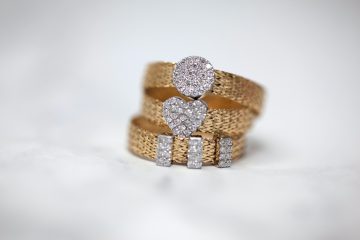Are you getting engaged or getting married soon?
Do you want to luxury spoil yourself with a sparkling diamond to impress your friends?
Want to know what makes some diamonds more valuable than others?
Do you want to know what to think about before buying diamonds? Then you have to read our diamond guide!
How diamonds are valued
Buying a diamond is for most people one of the larger individual investments you make in life, but what determines the value of diamonds and how can you tell if a diamond is genuine?
We will explain that and much more to you in the following section.
The four Cs – Cut, Color, Clarity & Carat
You usually talk about “the four C’s – Cut, Color, Clarity, and Carat” when talking about the value of diamonds. In Swedish you can translate it to grinding, color, purity and weight.
Cut – Grinding – The most important factor that determines the value and which gives the diamond its spark
The grinding is a diamond’s most important characteristic and has the greatest overall impact on a diamond’s beauty. It determines what we usually think of as a spark or the “bling factor”.
A diamond grinding degree is an objective measure of a diamond’s light performance, or what we usually think of as the spark. When a diamond is cut with the right proportions, the light is reflected back through the top of the diamond. If it is ground too shallow, light leaks out from the bottom and if it is ground too deep, light leaks out from the side.
Perfect grinding: Only 3% of all diamonds have this quality in grinding. This grinding reflects almost all the light that enters the diamond. An exquisite and rare cut.
Very good grinding: About 15% of all diamonds have this quality in grinding. It reflects almost as much light as a perfect cut, but for a lower price.
Good grinding: 25% of all diamonds reach this quality grade. It reflects most of the light entering the diamond. Diamonds with this grinding are much cheaper than those with very good grinding.
Nice grinding: About 35% of the diamonds come in this grinding quality. This is still a quality diamond, but it does not get as brilliant as one with good grinding.
Poor grinding: Diamonds with this grinding are generally so deep and narrow or shallow and wide that they lose most of the light through the sides and bottom.
Color – Color – The second most important factor that determines value. In a diamond, color appears as a slightly yellowish color. The less color a diamond has, the higher its rating and thus value.
After grinding, color is generally considered to be the second most important characteristic when choosing a diamond. This is because the human eye tends to detect a diamond’s spark first, and then the color.
Clarity – Purity – What are the pollutants in the diamond? Purity is classified according to the following scale, after analysis of experienced diamond graders with a magnification of 10 times magnification:
- LC Loupe clean, loupe. (Free from inclusions)
- Very very small inclusions. (Very, very small inclusions)
- VS Very small inclusions. (Very small inclusions)
- SI Small inclusions. (Small inclusions)
- In Inclusions. (Inclusions, visible to the naked eye)
Carat – Weight
Carat is a mass unit for diamonds, gemstones, and pearls. The word comes from Greek κερατιον which literally means little horn.
One metric carat is equivalent to 200 milligrams (0.2 grams). The international spelling carat is used interchangeably – this to avoid confusion with the purity measure carat used in gold valuation.
The definition of the metric carat was adopted in 1907 at the Fourth General Conference for Weight and Dimensions. ANSI X.12 The EDI abbreviation for carat is CD.
Diamond Certificates
A diamond certificate is an independent quality assessment from a third party regarding the diamonds you purchased. You should demand to get one when buying loose diamonds or jewelry with diamonds in it.
Internationally accredited diamond certificates are usually issued only for diamonds above 0.30 – 0.50 carat.
Some diamond certificate issuers you can trust we list below:
- GIA – Gemological Institute of America – http://www.gia.edu/
- EGL – European Gemological Laboratory – http://www.eglinternational.org/
- AGS – American Gem Society – http://agslab.com/
- HRD – High Council for Diamond – http://www.hrdantwerp.be/
- IGI – International Gemological Institute – http://www.igiworldwide.com/
- GIA and AGS are the diamond certification organizations that are most strict in their assessment of diamonds, but diamond certificates from the other three certification organizations (HRD, EGL and IGI) are fully acceptable.
What to think about before buying diamonds
Diamonds are often mined in areas of political instability, violence, and methods that violate human rights. It is important to consider the human costs associated with the diamond you are buying.
The Kimberly Process (The Kimberly Certification Scheme – KPCS) was established in 2003 to prevent conflict diamonds from reaching global markets. Conflict diamonds are defined as diamonds that finance rebel movements against recognized governments.
The Kimberley Process does not prevent diamonds from afflicted with violence, human rights violations, poverty, and environmental degradation from reaching the global markets.
Many jewel shops have extended their guarantees to more areas such that they do not come from areas where the extraction is in violation of human rights or that the extraction is done in an environmentally friendly way, etc.
Be sure that the shop you shop at, in addition to diamonds being conflict-free according to the Kimberley Process, also guarantees that the diamonds’ extraction has no connection to environmental degradation, human rights violations, violence, or other types of crime.



